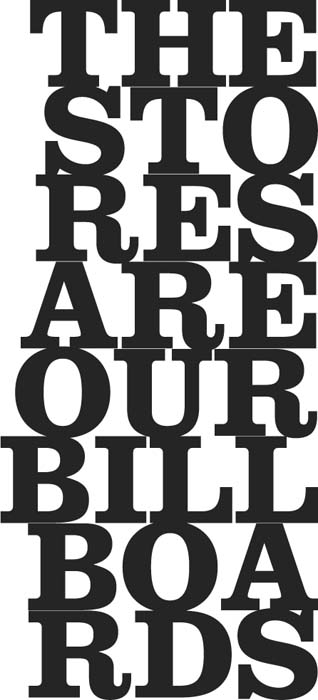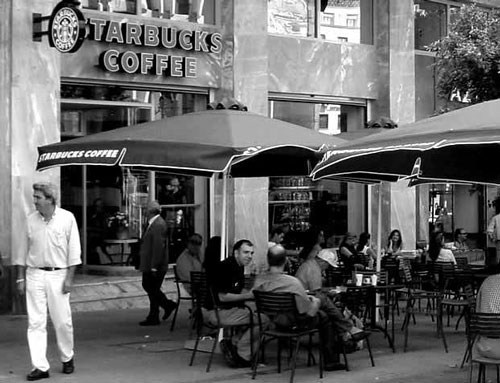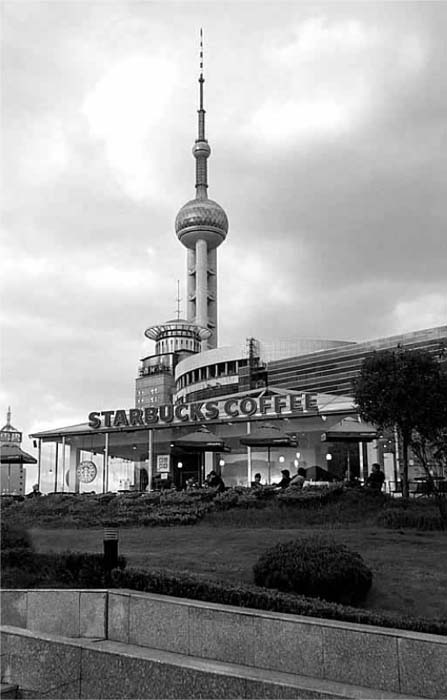The Starbucks Story (13 page)
Read The Starbucks Story Online
Authors: John Simmons

But the concept of romance then goes beyond this to
romancing the customer
, because Starbucks’ people are essential to projecting the brand. The interaction between partner and customer is fundamental. As Howard Behar put it: “We’re in the people business serving coffee.” So Starbucks needs to hire people who can interact comfortably, be easy, friendly and welcoming, maintain good eye contact, and listen to customers’ needs. Natural instinct can be reinforced through training, not only in the ways of coffee but in the values of the brand, starting with respect and dignity. All this helps to retain baristas, who stay longer and get better at their jobs, establishing relationships with regular customers.
Finally, it’s about
romancing the senses
, creating the complete experience in store by using all the senses. “The stores are our billboards,” therefore they have to express what the brand is all about: the smell of the coffee, the taste, the feel of the furniture, the look of the murals, the sound of the music. If you are to create the right experience, everything matters. Behind every decision is a judgment about truth to the brand: will this support or undermine it?

If these were building blocks added to those already in place, the structure was now becoming stronger. They represented layer upon layer of extra meaning rather than, as is the case with many big brands, a synthesis of meaning on one sheet of paper or in a single diagram. Unilever, for example, uses a “brand key” for all its brands, and this imposes a discipline of concise expression on all its brand managers. Starbucks goes a different route: because it insists on the continuing importance of intuition, it doesn’t want to distill its brand into a one-page statement. With Starbucks there is always more, a deeper level of understanding below the one you have achieved, and this makes for a deep and continually evolving brand that still manages to achieve a remarkable degree of consistency.
These were live issues when plans were being made for international development. What is the essence of the Starbucks brand? Can we bottle it and send it over to Japan, and throughout Asia? It turned out that Japan was the first and biggest test for the portability of the brand. It was clear when I talked to Howard Schultz eight years later that the entry to the Japanese market remained vivid. The company took it very seriously, even commissioning a blue-chip consultancy to advise on Japan. For Starbucks, with its leaning towards do-it-yourself, this was almost a revolutionary act. Yet its reaction to the consultancy’s recommendations showed Starbucks remaining true to its habitual trust in instinct.
When the study landed, heavily, on the boardroom table, it came out with a clear recommendation not to enter Japan.
There were three main objections:
1
Up to 90 percent of the business is take-away, and Japanese consumers would never be comfortable drinking coffee in the street.
2
The no-smoking policy would disenfranchise young Japanese, who would avoid stores that banned smoking.
3
The high cost of real estate in Japan would necessitate only small stores.
Starbucks listened and discussed the findings. Apart from Canada, it had no experience of overseas operations. Here, at the first time of exploration, they were being heavily warned off by a large, experienced and expensive management consultancy.
Starbucks had been doing its own homework. It had decided that it was interested in the Pacific Rim initially because Europe was already a mature coffee-drinking region. Japan, on the other hand, was a potentially large and developing coffee market. Other companies were starting to develop the market; if Starbucks hesitated, it might find it impossible to enter Japan later. Starbucks’ management resources were stretched thin, so it could not afford to hedge its bets by, say, testing Japan at the same time as a “friendly” market such as the UK. It was Japan now or never. So a joint venture was set up with the Sazaby company, whose brand and cultural values were felt to be similar. Yuji Tsunoda, a man who had lived in Los Angeles and believed that Starbucks would appeal to the Japanese, became head of Starbucks in Japan.
For Westerners, perhaps particularly for Americans, there is a wariness about the cultural gulf with Japan. Perhaps this is all the greater as it has reached a level of mythologizing through opera. Puccini’s
Madame Butterfly
and Sondheim’s
Pacific Overtures
, at different poles of a century, have placed the cultural divide at the center of an artistic exploration. But Japan has generally remained as inscrutable to Western eyes as Noh theater.
The anecdotal and statistical evidence presented to Starbucks showed that the Japanese liked coffee. Indeed, there was a growing local chain called Doutur, with 500 coffee shops. Starbucks believed it could offer higher quality and greater range, while appealing beyond the market of the salaryman to younger people and to women. But there were those three big objections, standing like guards at the gates of Japan. How should Starbucks react? The answer, inevitably, was to stick to the principles of the brand. Starbucks decided to press ahead with its decision to open stores in Japan, and it set the pattern for most of its international developments by entering into a joint venture with a locally focused company. Starbucks addressed the objections that the management consultancy had raised, and answered them in its own way. Howard Schultz still declares that he is not a big believer in consumer research; the Japanese experience will have reinforced his belief that it is real customers buying in your stores who provide the only true picture.
Starbucks’ reaction to the consultants’ third objection – high rents will mean small stores – was to remain true to the idea of the third place. Because customers who live and work in cities like Tokyo have relatively small homes and long commutes, there was an opportunity for larger stores that would be like extensions of the home. The rents would inevitably be high, but there was a belief that the greater density of population would make it pay to have more spacious stores rather than tiny kiosks.
The second objection – no-smoking stores would deter young Japanese – went to a fundamental principle about the relationship between the product and the brand. Starbucks had a no-smoking policy for a particular reason. It was not to make a health statement or take a moral stance. Because Starbucks placed such a high value on the quality of its coffee, it wanted to protect that quality. Coffee beans are highly absorbent: they take in smells from the environment around them. The simple fact is that smoke harms the coffee bean’s flavor and aroma. Starbucks’ first two stores in Japan had designated smoking and no-smoking areas, but by the opening of the third store the policy had reverted to no smoking in any Starbucks store. (This policy has remained, even in a country like Spain where there is a tradition of heavy smoking. It has become a differentiating factor that sets Starbucks apart from other coffee houses.)
The first of the consultants’ objections – the Japanese would not take to drinking take-away coffee – was harder to counter. It had to be a case of “try it and see.” In the event, if there was a cultural taboo about drinking coffee on the street, it was shattered in minutes. The Starbucks team were thrilled to see Japanese businessmen, students, mothers with children, women out shopping, all clutching their paper cups of coffee. And were they actually showing off the Starbucks logo for others on the street to see? It looked like it.

Hong Kong

Athens

Shanghai
Perhaps what Starbucks had not quite anticipated was the Japanese attraction towards brands they see as cool. Sometimes, as with Hello Kitty, this can be puzzling for people from outside Japan. But if you market your brand with the right degree of cool, the Japanese will spread their love for it by word of mouth. And they want to be seen to be associated with it, whether it’s wearing the T-shirt, carrying the shopping bag or drinking from the coffee cup. They express their individual likings as groups, too, so Starbucks became adopted in batches rather than simply one by one.
Things have settled in Japan since that first caffeine rush, but it remains one of Starbucks’ most successful markets. The Japanese service culture and commitment to teamwork played well to Starbucks’ own beliefs, so despite fears about a cultural clash between nations there was no cultural clash at a working level. Within five years, there were 300 Starbucks stores in Japan, the Japanese partners had their own stock option program, and the company was listed on the Japanese stock exchange. Whereas Starbucks initially and cautiously saw the target audience as young women, experience showed that the appeal was much broader. Japanese fan sites pop up on the internet. In Tokyo, a Starbucks in an upmarket department store is frequented by wealthy women who bring their children with them, although that had always been considered another cultural taboo.
Yet in other ways Starbucks has adapted to fit into the cultural background, with green-tea Frappuccinos and smaller cups to suit local preferences. Size does not matter – perhaps the hardest message for an American company to accept. The message that was easy to understand was that the traffic count (number of people passing through stores) is 33 percent higher in Japan than in the US. It is interesting, too, that whereas the take-out business represents 75 percent of sales in the US, it is just 25 percent in Japan.
Starbucks knew from a very early stage that Japan was going to succeed. People understood and liked the brand; there was no cultural disconnection. So it pressed ahead internationally while also moving forward on many other fronts. Stores opened in Singapore and Hawaii. Some of the remoter areas of the US – Arizona, Utah, Idaho – became part of the Starbucks map. A deal was struck with the Westin Hotels group. Continuing product development led to the introduction of Starbucks ice cream, which quickly become the number one brand of coffee ice cream in the US. Starbucks was on a roll and seemed unstoppable. That in turn led to a certain amount of resistance, because people always like to feel they have a choice. Scott Bedbury tells a story about meeting local objectors to Starbucks in San Francisco; their criticisms were that Starbucks would lead to the demise of local shops and reduce choice. The criticisms were largely defused by journalists asking how the employment policies of the local shops compared to Starbucks’. Time has shown that, in fact, greater choice has been created because the competition has to improve. If the local shops are good, they survive and thrive.